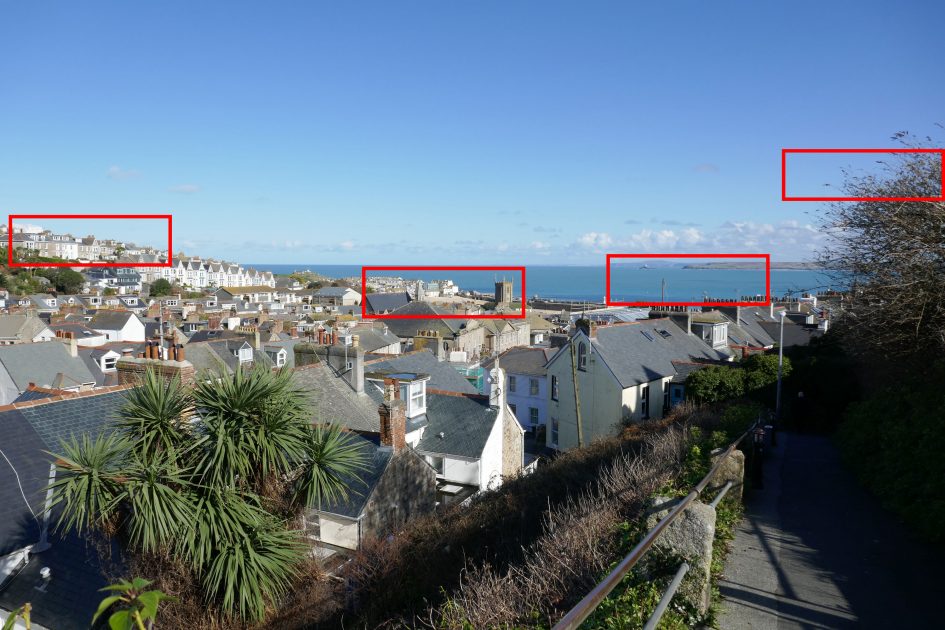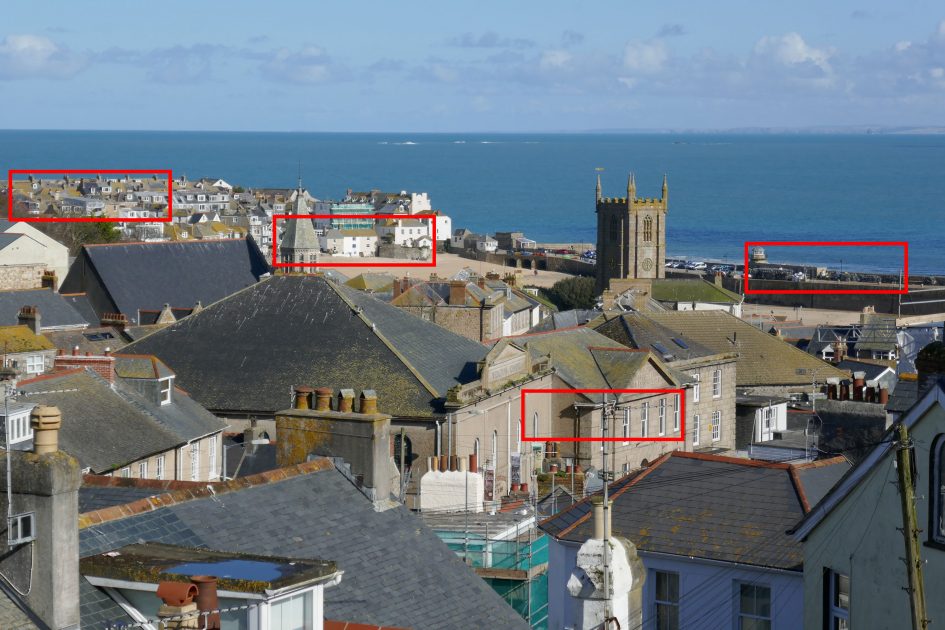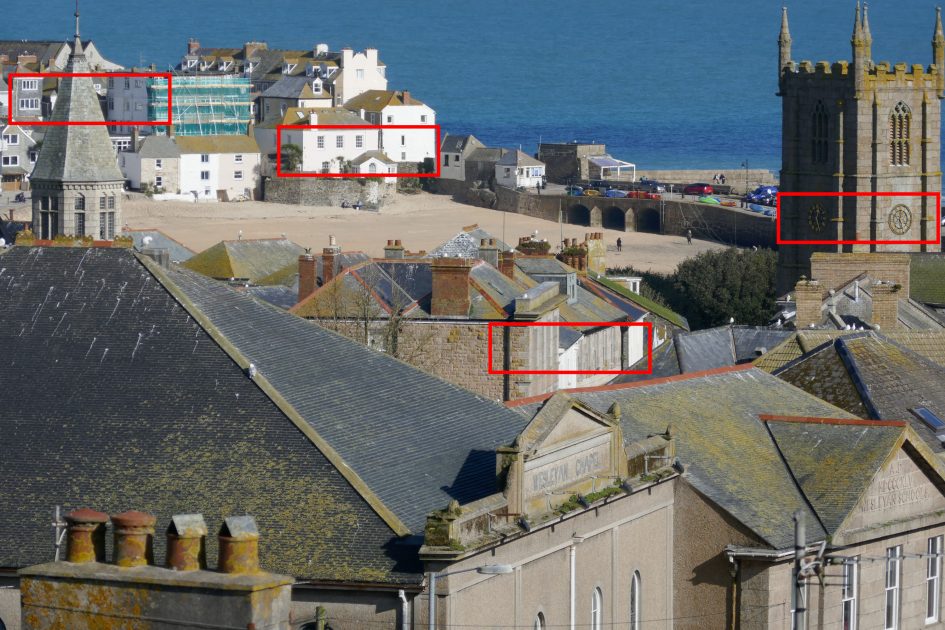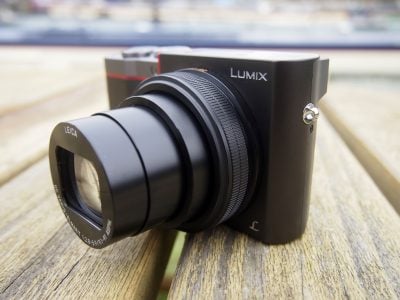Panasonic Lumix TZ100 / ZS100 review
-
-
Written by Ken McMahon
Quality

To test real-life performance, I shot this scene with the Panasonic Lumix TZ100 / ZS100 using its best quality JPEG mode. The TZ100 / ZS100 was mounted on a tripod and image stabilisation was disabled, the sensitivity was manually set to 125 ISO and Aperture priority mode was selected for the exposure.
I set the Aperture to f4 which I’d previously determined produced best results and the Lumix TZ100 / ZS100 chose a shutter speed of 1/1250.
The TZ100 / ZS100 has optional diffraction compensation which attempts to correct for the reduction in image quality caused by light diffraction at small aperture sizes. Diffraction compensation is turned off by default and so that’s where I left it for these quality tests.
Let’s take a look at the crops. The first table below shows the Lumix TZ100 / ZS100 at its widest 25mm coverage with, as I’ve said, the aperture set to f4. The crops are taken from across the frame with the first and last from close to the left and right edges with the crops two and three closer to the middle of the frame. In the first crop the detail looks a little bit soft, but that’s pretty much the only shortcoming, there’s little if any distortion and no colour fringing, so an excellent start for the TZ100 / ZS100.
The second crop is also pretty good. It’s not quite as soft as the first one, but neither are those edges as crisp as they could be. That said, there’s a very good level of detail here – you can make out the time on the church clock – nearly half past twelve, confirmed by the EXIF data. The third crop is more or less half way between the middle and edge of the frame and here things aren’t quite so clear. The lighthouse is a fair way off but you can still make out some detail, but the detail in the foreground at the bottom of the crop is a little less distinct.
Finally, the crop from the extreme right edge of the frame isn’t quite as sharp as the one from the left and there’s also quite a bit of colour fringing visible. Overall though this is a great result for the Lumix TZ100 / ZS100 at its wide angle setting. I can’t but wonder how much room there might be for improvement when processing RAW files. At the time of writing Adobe Camera RAW doesn’t support RAW files from the Lumix TZ100 / ZS100, but from the look of the in camera JPEGs I think it’s a fair bet that the sharpness could be increased a little. You could of course do this in-camera using a custom Photo Style.
Scroll down the page to see more quality results from the Lumix TZ100 / ZS100 at a range of longer focal lengths, to find out how it performs at higher sensitivities head for my Panasonic Lumix TZ100 / ZS100 noise results, skip to my Panasonic Lumix TZ100 / ZS100 sample images, or head straight to my verdict.

Panasonic Lumix TZ100 / ZS100 at 9.1mm (25mm equivalent)
f4 125 ISO

f4 125 ISO

f4 125 ISO

f4 125 ISO

Panasonic Lumix TZ100 / ZS100 quality at 50mm equivalent
The image above was taken with the Lumix TZ100 / ZS100 at 50mm equivalent. Just to note that as the lens is zoomed in on the TZ100 / ZS100, the maximum aperture closes. At each focal length tested I set the aperture to the maximum available – in this case f4.1. As before the camera was mounted on a tripod and stabilisation disabled. The crops are taken from the areas marked in red.
Zoomed in to 50mm the Lumix TZ100 / ZS100 turns in another set of very good quality crops. As before, Panasonic’s in-camera processing produces images with plenty of detail but they’re not overly crisp or contrasty. That’s not necessarily a bad thing, most people will be more than happy with results of this quality on full sized prints and if they’re not, there’s always custom Photo Styles or RAW processing to get you you closer to what you want. The other thing to say about the quality of these crops is there’s no visible noise. Where you might expect to see some graininess – in the flat blue colour of the sea at the top of crops one and two, or anywhere in the final crop, there’s no hint of any noise texture. Another win for the Lumix TZ100 / ZS100’s 1 inch sensor and Panasonic’s in-camera JPEG processing.
Scroll-down for results at a longer focal length, or skip to my noise results.

Panasonic Lumix TZ100 / ZS100 at 18.2mm (50mm equivalent)
f4.1 125 ISO

f4.1 125 ISO

f4.1 125 ISO

f4.1 125 ISO

Panasonic Lumix TZ100 / ZS100 quality at 100mm equivalent
For this next set of crops I zoomed the TZ100 / ZS100 in to 100mm equivalent. The first crop in this set, again from close to the left edge of the frame, isn’t quite as sharp and doesn’t have the same level of detail as the earlier ones at shorter focal lengths. Moving towards the middle of the frame, the second crop is likewise a little soft, though it is an improvement. The improvement continues with the third crop – the most central – looking nice and crisp. Intertestingly the fourth crop from the extreme right edge of the frame also displays crisp edges and lots of detail. With no signs of distortion or lens aberrations, it’s another excellent result for the Lumix TZ100 / ZS100 at this just short of mid range focal length.
Scroll-down for results at a longer focal length, or skip to my noise results.

Panasonic Lumix TZ100 / ZS100 at 36.6mm (100mm equivalent)
f5.2 125 ISO

f5.2 125 ISO

f5.2 125 ISO

f5.2 125 ISO

Panasonic Lumix TZ100 / ZS100 quality at 250mm equivalent
For this final comparison, I zoomed the TZ100 / ZS100 in to its maximum 250mm equivalent focal length. If the detail in these crops looks less clear than in the earlier ones taken at shorter focal lengths that’s in part due to atmospheric conditions – there’s a lot of air between the lens and the subject in these crops which affects the image quality to a degree. Depth of field can also be an issue.
Despite that though, there’s still a good level of detail in the first crop, but there’s also the hint of some purple colour fringing. The second crop is a little soft, again, but the final two crops at this focal length are nice and sharp with plenty of detail. So a strong finish to cap out an overall excellent set of quality results for the Lumix TZ100 / ZS100.

f5.9 125 ISO

f5.9 125 ISO

f5.9 125 ISO

f5.9 125 ISO
Panasonic Lumix TZ100 / ZS100 JPEG noise
To examine noise levels under real-life conditions, I shot this scene with the Panasonic Lumix TZ100 / ZS100 at each of its ISO settings.The TZ100 / ZS100 was set to RAW+JPEG mode and mounted on a tripod with stabilisation disabled.
The camera was set to its maximum wide angle 25mm equivalent view. The ISO sensitivity was manually set to the lowest available setting and Aperture priority mode was selected for the exposure.
I’d previously determined that f4 produced the best results from the TZ100 / ZS100 and with the aperture set to f4 and the sensitivity set to 125 ISO, the the TZ100 / ZS100 metered an exposure of 0.6s.
Just to note the sensitivity range of the Lumix TZ100 / ZS100 is 125 to 12800 ISO, but it can be extended to 80 to 25600 ISO. For the sake of completeness I’ve included the extended settings but just be aware the base sensitivity setting in the normal range is 125 ISO.
In fact, looking at the 80 and 100 ISO crops below, eagle-eyed pixel-peepers will notice that they’re a little bit more contrasty than the base 125 ISO crop and they’re also marginally less saturated so, though there are some situations that might benefit from a lower sensitivity setting, for most situations you should treat 125 ISO as the base sensitivity setting.
As you’d expect, the Lumix TZ100 / ZS100 crops in the low end of the sensitivity range look clean and well detailed. It’s in the middle and upper end of the range that there’s a big improvement in noise levels over the earlier TZ70 / Z50 with it’s 12 Megapixel 1/2.3in sensor. Though it has a higher 20.1 Megapixel reolution, the Lumix TZ100 / ZS100’s 1 inch sensor has more than four times the surface area, resulting in a much lower pixel density and greatly improved noise performance.
Looking at these 100 percent crops, though there’s noise creeping in at 800 and 1600 ISO the TZ100 / ZS100 is producing relativley clean images with good levels of detail in the middle of the sensitivity range, that’s not something you could expect from a smaller sensor compact. Things start to look a litle grungy at 3200 ISO and above, but it’s not until you hit 12800 ISO that the noise overwhelms the image detail. By now you’re definitley into emergency use only territory.
While we don’t have side by side comparisons, comparing these crops with previous noise results from other one inch sensor compacts like the Sony RX100 III and IV and the Canon PowerShot G7X, I’d say the Lumix TZ100 / ZS100 compares favourably at the lower end of the sensitivity range, I’m just not convinced that Panasonic can match Sony and Canon’s performance at the mid and high ISO sensitivities. The RAW results might shed some light on how much that’s due to the Lumix TZ100 / ZS100’s in-camera JPEG processing. As soon as Camera RAW support becomes available for the Lumix TZ100 / ZS100 I’ll update these results.

Panasonic Lumix TZ100 / ZS100 JPEG
80 ISO

100 ISO

125 ISO

200 ISO

400 ISO

800 ISO

1600 ISO

3200 ISO

6400 ISO

12800 ISO

100 ISO
25600 ISO
Check prices at Amazon, B&H, Adorama, eBay or Wex. Alternatively get yourself a copy of my In Camera book, an official Cameralabs T-shirt or mug, or treat me to a coffee! Thanks!




